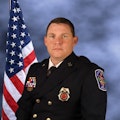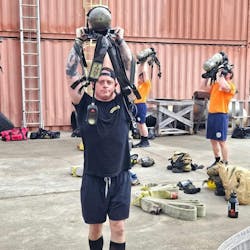Setting the Standard: Modeling Professionalism in Fire Service Mentorship
Key Highlights
- Fire department mentors are the bridge between theory and practice, between knowing what to do and understanding how to do it with competence, composure and integrity.
- Mentors not only show young firefighters the tasks of their role but also how to carry themselves as professionals under scrutiny, how to communicate respectfully under stress and how to make ethical choices when no one else is looking.
- Veteran firefighters who mentor well offer four gifts that shape the career of their mentee: orientation, validation, protection and direction.
The first time that I handed a hydraulic rescue tool to Alex, who was our newest recruit at the time, his gloves trembled on the grips. The scene was a two-vehicle collision, metal twisted like a pretzel, with EMS kneeling beside a trapped driver. Alex knew the tool’s specifications from the academy. He passed the written test. However, in the noise, the chaos and the raw urgency of a real-life extrication, the confidence from the classroom evaporated.
I knelt beside him, steadied his hands and talked him through every step. “Set your stance. Breathe. Listen for the command. You’ve got this.”
The cut went clean. The patient was freed. That said, what happened after was just as important. Back at the station, we stayed up late for a one-on-one session. We practiced. We reviewed. We talked about why every movement mattered—not just for efficiency, but for safety, teamwork and public trust.
Weeks later, Alex was on the tool again at a major wreck. This time, his grip was steady, his work was precise. Afterward, he told me, “That night in the bay changed everything for me.”
That’s mentorship in action, and at the heart of that process is something that every great mentor must master: modeling professionalism.
Mentor’s real role
In the fire service, mentorship isn’t just a tradition; it’s survival. The gap between academy training and real-world fireground realities is wide. No textbook ever will replicate the heat, confusion and split-second decision-making of a working fire or the emotional toll of helping a family on the worst day of their lives.
That’s where mentors come in. They are the bridge between theory and practice, between knowing what to do and understanding how to do it with competence, composure and integrity. Although mentors share technical skills, their most important contribution is showing—through their own conduct—what professionalism looks like in every situation.
Professionalism: More than a buzzword
The term “professionalism” gets thrown around a lot, but in the fire service, it isn’t about wearing a pressed uniform or delivering polished soundbites. It’s a daily commitment to the values and behaviors that keep crews safe and the public’s trust intact.
In practice, professionalism means:
- Competence. Knowing your job inside and out and keeping your skills sharp.
- Integrity. Doing the right thing, even when nobody’s watching.
- Respect. Treating everyone—teammates, citizens, superiors—with dignity.
- Accountability. Owning your actions, learning from mistakes and improving.
- Composure. Staying steady in high-pressure moments.
- Service orientation. Putting mission and community above ego.
For a mentor, these aren’t just personal traits. They’re lessons in motion, visible in every decision, every word and every interaction. Mentees won’t just hear what you say; they’ll watch what you do.
Why modeling matters more than ever
Today’s fire service faces pressures that previous generations never imagined. Social media makes every action public. Cameras are everywhere. Communities expect transparency, compassion and precision. Internally, departments juggle generational differences, evolving tactics and increased mental health awareness.
For rookies who step into this world, mentors aren’t just teaching them how to pull a line. They’re showing those young firefighters how to carry themselves as professionals under scrutiny, how to communicate respectfully under stress and how to make ethical choices when no one else is looking.
A key reminder is that the culture of a department is shaped by what the veterans do, not what they say that they value. If the experienced hands cut corners, belittle others or ignore safety protocols, the rookies will absorb those behaviors just as quickly as they learn how to throw a ladder.
Four essential gifts, through the professional lens
Veterans who mentor well offer four gifts that shape careers:
- Orientation. Showing the new firefighter not only what to do but how to operate within the culture, with professionalism as the baseline.
- Validation. Recognizing progress and effort, to reinforce that professional conduct gets noticed and appreciated.
- Protection. Standing up against hazing or unprofessional treatment, to prove that respect is nonnegotiable.
- Direction. Charting a path toward leadership, advanced training and community trust.
Nonnegotiables for mentors
If you’re going to model professionalism effectively, certain behaviors aren’t optional:
- Be technically sharp. You can’t model what you don’t know.
- Communicate clearly. On scene, that means concise instructions; in the station, that means constructive feedback without belittlement.
- Stay emotionally steady. The rookie will mirror your stress responses. Show calm.
- Lead by example. If you expect gear checks at 7:00 a.m., be the one who’s already done yours at 6:50 a.m.
- Own your mistakes. A mentor who admits errors teaches humility and growth.
Culture: The double-edged sword
The firehouse is a second home, full of camaraderie, tradition and shared purpose. However, culture can either lift professionalism or undermine it.
The professional mentor helps the rookie navigate:
- Camaraderie without cruelty. Friendly ribbing builds bonds; harassment destroys them.
- Tradition with judgment. Not every “old way” aligns with modern safety standards.
- Respect across ranks. Titles matter but so does recognizing the dignity of every member.
The long game: Professionalism pays forward
A professional mentor’s influence extends far beyond one rookie. When you model high standards, you raise the bar for the entire crew, you reinforce public confidence in the department, you preserve institutional knowledge that’s worth passing down and you create future mentors who will keep the cycle alive. In other words, your example becomes part of the department’s DNA.
The Alex Effect
Looking back at Alex’s growth, I see more than a firefighter who learned how to handle a rescue tool. I see a professional who now arrives early, checks his gear without prompting and mentors other rookies with patience.
One night after a call, I overheard him telling a probie, “We don’t just do it this way because it works. We do it this way because it’s safe, it’s respectful and it’s what the public expects of us.”
That’s the type of moment when you know that professionalism took root—when your mentee starts planting those seeds in someone else.
Challenges and how to overcome them
Even the most dedicated mentor will face obstacles:
- Burnout. The grind can tempt you to cut corners. Fight it.
- Toxic traditions. Breaking old habits means standing up to peers.
- Generational gaps. Adapt your approach without lowering your standards.
Professional mentors confront these head-on, knowing that the rookie is watching how they handle adversity.
Practical tips for mentors:
- Be visibly committed. Let the rookie see you doing the work without shortcuts.
- Make every call a teaching moment, even the quiet ones.
- Keep feedback private. Praise in public, correct in private.
- Encourage questions. A curious rookie is a growing rookie.
- Document development. Track a rookie’s progress as you would track training hours.
About the Author

Wayne Jones
Wayne Jones is a 29-year student of the fire service who currently serves as a captain in the Training Division with Horry County, SC, Fire Rescue. He is an adjunct instructor for South Carolina Fire Academy and is a graduate of Columbia Southern University. Jones is the creator of the social media page, The Firefighters Chalkboard, and is the author “Step Up to The Chalkboard” and “The Why Before the How: A Modern-Day Approach to Teaching Fire Service Students.”
